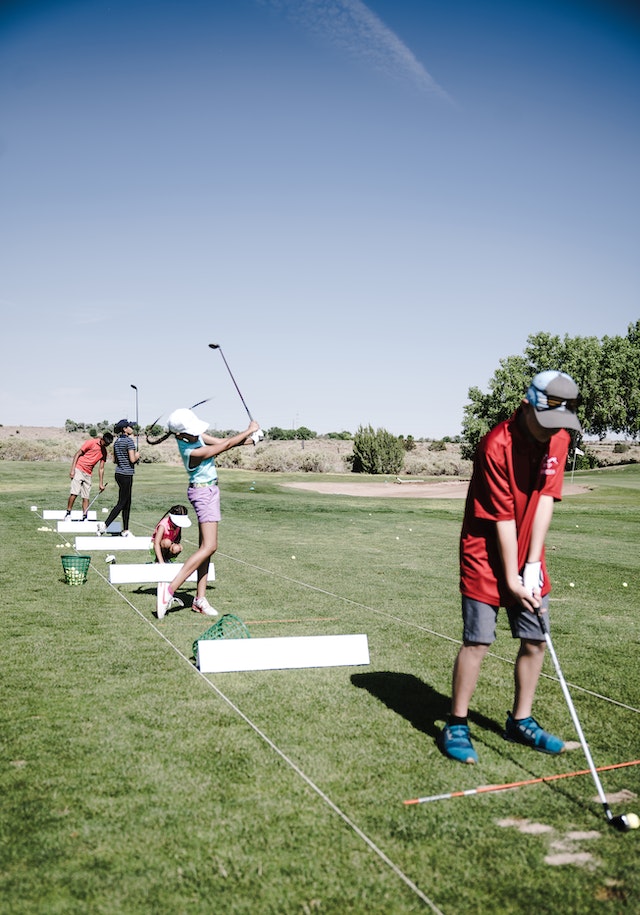In the world of golf, the importance of regular practice can never be overstressed. One area where golfers, both professionals and amateurs, spend copious amounts of time practicing is the driving range. But what is a driving range, and how can we make the most out of our time there? Let's find out.
What is a Driving Range?
A driving range is a designated area where golfers can practice their golf swings. The scope for improvement a driving range offers golfers is immense: from novice players mastering the basics to professionals fine-tuning their swings.
Read also: How to Hold a Golf Club Correctly
Driving ranges come in various forms, including open-air ranges, covered ranges, and even multi-story ranges. Amenities can range from small pro shops and club-fitting centres to high-tech simulation rooms.
Crucially, driving ranges can recreate almost every scenario you’d encounter on the golf course, allowing golfers to practice their hits with their golf clubs in varied conditions.
Check the best golf training aids in our online store!
What are Driving Ranges for?
The driving range serves as an excellent platform to improve several aspects of your game. From enhancing your driving distance and accuracy to working on your swing speed, the driving range offers extensive practicing opportunities.
The benefits are manifold: improved swing techniques, a better understanding of golf mechanics, increased ability to handle different course conditions, and an overall improved game.
Read also: What is bounce in golf clubs?
What Golf Clubs Should You Bring to the Driving Range?
As you prepare for a productive session at the driving range, figuring out which clubs to carry is integral to your preparation. We suggest bringing along four different types of clubs: the driver, wedge, iron, and putter.
Drivers
The driver, or the 1-wood, is often the first club out of the bag on many golf courses while teeing off. It enables you to practice long-range shots, which are essential in most golf courses. A session with driver golf clubs at the driving range can help you improve your power and accuracy for those crucial initial tee-off shots.
Wedges
Wedge golf clubs are primarily used for short shots, particularly when you aim to get the ball onto the green from a relatively close range. This includes skills like chipping, pitching, or getting out of a sand bunker. Practicing with a wedge on the driving range can greatly enhance your precision and finesse for the short game.
Irons
Irons are versatile clubs that allow you to practice a variety of shots at different distances. They are used in a range of scenarios on the golf course, from teeing off (on shorter holes) to making approach shots onto the green. By utilizing irons at the driving range, you refine your ability to strike the ball at varying distances accurately, adaptable to any situation on the course.
Putters
Typically, the driving range is not the first place you'd think of taking putter golf clubs but using a putter allows golfers to practice control and accuracy. Again, while you usually use this club on the greens for the final strokes, it is an interesting approach to practice your stroke on a flat surface at the range before hitting the actual greens.
Indeed, the driving range offers a diverse practice ground to simulate various golf course scenarios with differing clubs. Each club helps you practice and improve a different aspect of your game under various conditions.
The key to becoming a better golfer lies in these varying practice sessions' versatility – an opportunity that the driving range provides in plenty. Carry these four clubs to your next range session, and witness the transformation in your skills.
Read also: Which golf club to use and when
The Dos and Don'ts of a Driving Range
Dos of a Driving Range
The following are some essential practices to adopt while at the driving range.
- Use the right golf clubs: While practicing, ensure you use the appropriate clubs to hone your skills across the board and not just on particular shots.
- Warm-up: Always ensure you do some warm-up exercises before you start hitting balls. It helps to prepare your body for the task, reducing the risk of injury.
- Improving swing techniques: Your primary focus on the range should be fine-tuning your swing technique. Work on your grip, stance, backswing, and follow-through.
- Routine practice: The more you practice, the better your game gets. Make it a habit to visit the range regularly.
- Engage professional instructors: To get the most out of your time at the range, consider getting coaching sessions from professional instructors.
Don'ts of a Driving Range
While there are plenty of do's at the driving range, there are also a number of don’ts you should be aware of.
- Avoid over-swinging: Over-swinging, while trying to hit further, is a common mistake. It often results in inaccurate shots and could lead to injuries.
- Respect safety rules: Always adhere to safety rules at the driving range. This includes areas like waiting for your turn, not swinging your club recklessly, and observing designated hitting areas.
- Avoid bad practice habits: Practicing the wrong techniques can be detrimental to your game. Make sure your practice is always in line with proper golfing techniques.
- Don’t just focus on power: While it's exciting to hit further, don't forget the importance of accuracy and technique. A balanced approach to power and technique will help you improve more effectively.
Final thoughts
The driving range is a golf playground offering the chance to practice and perfect your swing. With our handy list of do's and don'ts, you can now make the most of your time in the driving range. Ironically, mastering golf involves thinking less about golfing and more about practicing. So, take your golf clubs and head to the driving range today!
 Reviews on
Reviews on 


